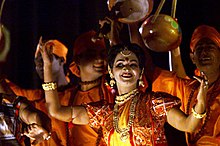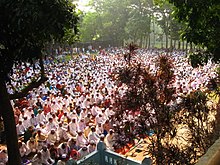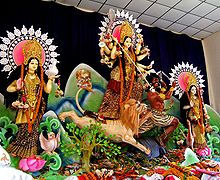The Culture of Bangladesh (Bengali: বাংলাদেশের সংস্কৃতি —Bangladesher Sôngskr̥iti) refers to the way of life of the people of Bangladesh. It has evolved over the centuries and encompasses the cultural diversity of several social groups of Bangladesh. The Bengal Renaissance of the 19th and early 20th centuries, noted Bengali writers, saints, authors, scientists, researchers, thinkers,music composers, painters, and film-makers have played a significant role in the development of Bengali culture. The Bengal Renaissance contained the seeds of a nascent political Indian nationalism and was the precursor in many ways to modern Indian artistic and cultural expression. The culture of Bangladesh is composite and over the centuries has assimilated influences of Islam, Hinduism, Buddhism, and Christianity. It is manifested in various forms, including music, dance, and drama; art and craft;folklore and folktale; languages and literature; philosophy and religion; festivals and celebrations; as well as in a distinct cuisineand culinary tradition.
Music, dance, drama
See also: Music of Bangladesh and Performing arts of Bangladesh

Bangladeshi artists performing in a dance show.
The music and dance styles of Bangladesh may be divided into three categories: classical, folk, and modern.
The classical style has been influenced by other prevalent classical forms of music and dances of the Indian subcontinent and, accordingly, show some influenced dance forms like Bharata Natyamand Kuchipudi.
Several dancing styles in vogue in the northeastern part of the Indian subcontinent, like Manipuri and Santhali dances, are practiced, but Bangladesh has developed its own distinct dancing styles. Bangladesh has a rich tradition of folk songs, with lyrics rooted in vibrant tradition andspirituality, mysticism, anddevotion. Such folk songs revolve around other themes, including love. The most prevalent folk songs and music traditions include Bhatiali, Baul, Marfati, Murshidi, and Bhawaiya. Lyricists like Lalon Shah, Hason Raja,Kangal Harinath, Romesh Shill, Abbas Uddin, and many unknown anonymous lyricists have enriched the tradition of folk songs of Bangladesh.
In a relatively modern context, Robindro Shongit and Nazrul Giti form precious cultural heritage of Bangladesh. Recently, western influences have given rise to quality rock bands, particularly in urban centers like Dhaka. Several musical instruments, some of them indigenous, are used in Bangladesh, and major musical instruments used are the bamboo flute (bashi), drums (dhol), a single stringed instrument namedektara, a four-stringed instrument called dotara, and a pair of metal bawls used for rhythm effect calledmandira, are important in the culture of Bangladesh. Currently,musical instruments of western origin like guitars, drums, and the saxophone are used, sometimes along with traditional instruments (Muajj).
Media and cinema
Main articles: Media of Bangladesh and Cinema of Bangladesh
The Bangladeshi press is diverse, outspoken and privately owned. Over 200 newspapers are published in the country. Bangladesh Betar is the state-run radio service.[1] The British Broadcasting Corporation operates the popular BBC Bangla news and current affairs service. Bengali broadcasts from Voice of America are also very popular. Bangladesh Television (BTV) is the state-owned television network. There more than 20 privately owned television networks, including several news channels. Freedom of the media remains a major concern, due to government attempts at censorship and harassment of journalists.
The cinema of Bangladesh dates back to 1898, when films began screening at the Crown Theatre in Dacca. The first bioscope in the subcontinent was established in Dacca that year. The Dhaka Nawab Familypatronized the production of several silent films in the 1920s and 30s. In 1931, the East Bengal Cinematograph Society released the first full-length feature film in Bangladesh, titled the Last Kiss. The first feature film in East Pakistan, Mukh O Mukhosh, was released in 1956. During the 1960s, 25-30 films were produced annually in Dacca. By the 2000s, Bangladesh produced 80-100 films a year. While the Bangladeshi film industry has achieved limited commercial success; the country has produced notable independent film makers. Zahir Raihan was a prominent documentary-maker who was assassinated in 1971. The late Tareque Masud is regarded as one of Bangladesh's outstanding directors due to his numerous productions on historical and social issues. Masud was honored by FIPRESCI at the Cannes Film Festival in 2002 for his filmThe Clay Bird. Tanvir Mokammel, Mostofa Sarwar Farooki, Humayun Ahmed, Alamgir Kabir, Subhash Duttaand Chashi Nazrul Islam are other prominent directors of Bangladesh cinema.
Festivals and celebrations
Festivals and celebrations are an integral part of the culture of Bangladesh. Muslim festivals of Eid ul-Fitr, Eid ul-Adha, Milad un Nabi, Muharram, Chand raat, Shab-e-Baraat, Bishwa Ijtema; Hindu festivals of Durga Puja,Rath Yatra, Janmashtami; Buddhist festival of Buddha Purnima; Christian festival of Christmas and secular festivals like Pohela Boishakh, Language Movement Day, Independence Day, Rabindra Jayanti, Nazrul Jayanti witness widespread celebrations and are national holidays in Bangladesh.
Eid ul-Fitr
Main article: Eid ul-Fitr

Males from around the Barashalghar union of Comilla'sDebidwar upazila can be seen attending Khutbah as part of the Eid-ul-Fitr prayers
As the most important religious festival for the majority of Muslims, the celebration of Eid ul-Fitr has become a part of the culture of Bangladesh. The government of Bangladesh declares the holiday for three days on Eid-ul Fitr. But practically, all schools, colleges and offices remain closed for a week. This is the happiest time of the year for most of the people in Bangladesh. All outgoing public transport from the major cities have become highly crowded and in many cases the fares tend to rise in spite of government restrictions. On Eid day, the Eid prayers are held all over the country, in open areas like fields, Eidgahs or inside mosques.[2] After the Eid prayers, people return home, visit each other's home and eat sweet dishes called Shirini,Sheer Khurma and other delicacies like biryani, kofta, kebab etc. Throughout the day people embrace each other and exchange greetings. It is also customary for junior members of the society to touch the feet of the seniors, and seniors returning blessings (sometimes with a small sum of money as a gift). Money and food is donated to the poor. In the rural areas, the Eid festival is observed with great fanfare. Quiet remote villages become crowded. In some areas Eid fairs are arranged. Different types of games includingboat racing, kabaddi, and other traditional Bangladeshi games, as well as modern games like cricket andfootball are played on this occasion. In urban areas, people play music, visit each other's houses, arrange picnics and eat special food. The homes, streets, markets and parks are illuminated with lighting decorations in the evening. Watching movies and television programs has also become an integral part of the Eid celebration in urban areas. All local TV channels air special program for several days for this occasion.
Eid ul-Adhha
Main article: Eid ul-Adha

An urban congregation for Eid-ul-Adha prayers in Dhaka.
The second most important religious festival. The celebration of Eid ul-Adha is similar to Eid ul-Fitr in many ways. The only big difference is the Qurbani or sacrifice of domestic animals on Eid ul-Adha. Numerous temporary marketplaces of different sizes called hatoperate in the big cities for sale of Qurbani animals (usually cows,goats and sheep). In the morning on the Eid day, immediately after the prayer, affluent people thank God for the animal, and then sacrifice it. Less affluent people also take part in the festivity by visiting houses of the affluent who are taking part in qurbani. After the qurbani, a large portion of the meat is given to the poor people. Although the religious doctrine allows the sacrifice anytime over a period of three days starting from the Eid day, most people prefer to perform the ritual on the first day of Eid. However, the public holiday spans over three to four days. Many people from the big cities go to their ancestral houses and homes in the villages to share the joy of the festival with friends and relatives.















